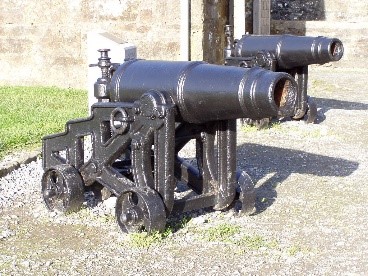

 |

|
|
Carronades vs. Long Guns The standard problem with front-loading cannon is windage. This is the gap between the cannonball and the side of the barrel. The larger the windage the more black powder is required and the lower the efficiency of the charge. This larger charge requires heavier, thicker barrels and increases the weight of the gun. The gun also needs to have a long barrel, to concentrate the force of the blast over the length of the tube and improve accuracy. Hence the name, long guns. Typical long guns have windage of about a quarter of an inch. Such a gap requires a large powder load, but it also has one advantage, it's easy to load. With such a large gap, the ball can literally be rolled down the tube. This ease of loading increases the rate of fire. In 1778, the Scottish Carron Company developed a technique to reduce the gap to less than 1/10th of an inch. This lets far less gas escape. As a result, the canon needed less of a black powder charge, since less of the expanding gas was escaping. This resulted in thinner walls for the barrel and lighter overall weight. Weight is important on a ship… if you want to keep it afloat. So, lighter weight guns on a ship had an advantage, as it allowed twice as many guns to be placed on any given ship. But these advances came with a cost. With less of a gap, and unburned material could block the tube, keeping the ball for loading correctly. Thus the carronade was built as a short-barreled gun, so that it would be easier to clean and keep the tube free of unburned powder. The short barrel and the lower amount of powder resulted in a shorted range for the ordnance. The result is that ships regularly carried both long guns and carronades if they were available. One for long-distance fire and both for short distance work. For field artillery however, long guns were exclusively used. This was because of their ease of loading which resulted in a higher rate of fire. .
|
|